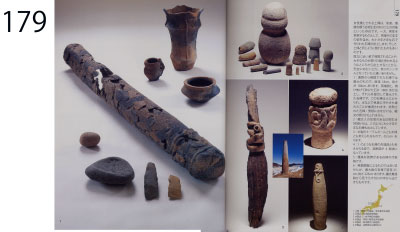Clay figurines, considered to be female, are objects with which the people prayed for safe births and a good harvest in their day-to-day life.
On the other hand, there are unearthed objects expressing the male gender such as stone rods of various sizes, including those in the shape of a phallus as it is. Similar to the clay figurines, many are broken.
Because they have been excavated in an almost upright stance, and large pieces have been unearthed from locations that seem like communal areas, these pieces rising high into the open sky must have been a symbol of celebration.
1 (p. 178):
This is the largest stone rod excavated, being 18 cm in diameter and 184 cm in length. Both ends and more than 1800 burnt, fragmented pieces were unearthed. By putting them together, this piece was reconstructed.
It is surmised that this stone rod was broken by putting it over fire then cooling it immediately after. Pouring water over red-hot stone rods and phalluses – this might have been a Jomon ritual.
2 (top, p. 179):
Stone rods of all sizes, like those shown in No. 2, have been excavated from dwelling sites where the Jomon people spent their daily life.
3 (bottom left, p. 179):
This is either a totem pole made of wood, or a wood figurine, 65.5 cm in height.
4 (middle right, p. 179):
This may be the head of a stone rod, like the one in No. 1. The decorative part has four sides.
5 (bottom right, p. 179):
A typical stone rod with refined decorations.
6 (lower center, small pic., p. 179):
This is the biggest stone rod, 25 cm in diameter and 223 cm in height. This was unearthed not through an archaeological survey but was found in a river that a Jomon settlement site overlooks.
